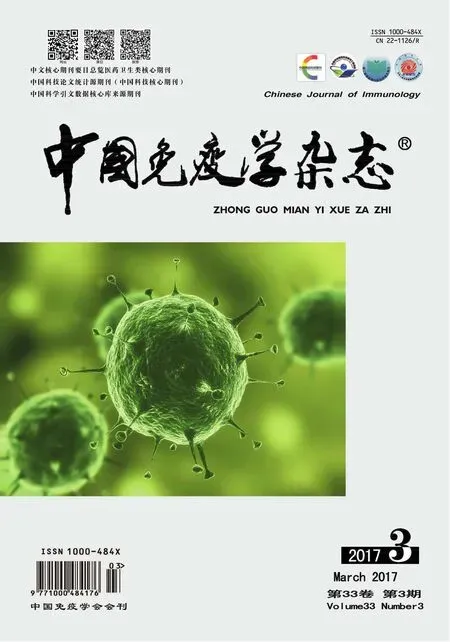不同类型供者造血干细胞移植治疗儿童再生障碍性贫血的进展
2017-01-16谭业辉
何 平 王 畅 谭业辉
(长春医学高等专科学校,长春130031)
不同类型供者造血干细胞移植治疗儿童再生障碍性贫血的进展
何 平 王 畅①谭业辉①
(长春医学高等专科学校,长春130031)
再生障碍性贫血(Aplastic anemia,AA)是小儿常见贫血性疾病,分为先天性及获得性;是一种多类病因和发病机制引起的骨髓造血功能衰竭征,主要表现为骨髓有核细胞增生低下、全血细胞减少及所致的贫血、出血和感染[1]。西方国家发病率(1~2)/百万,东方国家发病率约为西方国家的3倍左右[2]。非重型再生障碍性贫血(Non severe aplastic anemia,NSAA)主要以支持对症和促造血治疗为主,重型再生障碍性贫血(Severe aplastic anemia,SAA)异基因造血干细胞移植(Hematopoietic stem cell transplantation,HSCT)和免疫抑制剂治疗(Immunosuppressive therapy,IST)是主要手段。
年龄是影响AA疗效和治疗决策的重要因素。40岁以下具有同胞全相合供者的成人SAA,首选异基因造血干细胞移植治疗,40岁以上和40岁以下成人无同胞全合供者的SAA则以IST为一线治疗[3]。儿童SAA因HSCT疗效好,长期生存率高,并发症少,HSCT多数情况下为一线治疗选择[4]。近年来,随着移植技术的进步,HSCT治疗儿童SAA的疗效逐步提高,在供者选择上也取得了显著的进展。以下将围绕HSCT同胞全合移植、无关供者移植、单倍体移植进行综述。
1 HLA全相合同胞供者移植(HLA matc-hed sibling donor hematopoietic stem cell transplantation,MSD HSCT)
MSD HSCT因有高植入率和生存率,较低的并发症及移植相关死亡率(Treatment-related mortality,TRM),一直以来都是儿童SAA的首选治疗。整体生存率均在90%以上[5-7]。环磷酰胺联合抗人胸腺细胞球蛋白(Anti-human thymocyte globulin,ATG)是标准预处理方案[8]。为了减少环磷酰胺的毒性,在预处理方案中加入氟达拉滨,减少环磷酰胺剂量,可以取得与标准预处理方案类似的生存率[9,10]。因再生障碍性贫血的发病机制主要与免疫异常介导的干细胞损伤有关,ATG联合环孢菌素A(Cyclosporin A,CSA)的IST治疗可以获得70%~88%的反应率[6,7,11],因此在无同胞全合供者的情况下,多以IST为一线治疗。但与MFD HSCT比较,存在治疗失败、复发及克隆演变等相关问题。
来自日本的研究显示,17岁以下儿童SAA接受MSD HSCT对比IST一线治疗,两组患者的10年整体生存率(Overall survival,OS)差异(92% vs 88%,P=NS),但MSD HSCT组10年无失败生存率(Failure free survival,FFS)远远高于IST组(87% vs 56%,P<0.001)。IST组治疗失败、复发、发生克隆演变的比例明显高于MSD HSCT[6]。欧洲骨髓移植协作组重型再生障碍性贫血工作组(Severe Aplastic Anaemia Working Partydatabase of the European Society for Blood and Marrow Transplantation,EBMT SAAWP)关于0~12岁以下儿童SAA的数据显示了类似的结果,MSD HSCT与IST治疗3年OS与IST组类似(91% vs 87%),但IST组FFS显著低于MFD HSCT(33% vs 87%,P<0.0001)。IST治疗失败患儿,接受包括MSD HSCT、无关全合供者移植(Matched unrelated donor hematopoietic stem cell transplantation,MUD HSCT)、不全相合同胞供者移植(Mismatched sibling donor hematopoietic stem cell transplantation,MMSD)或不全相合无关供者移植(Mismatched unrelated donor hematopoietic stem cell transplantation,MMUD HSCT)等各种方式的挽救HSCT治疗,可再次获得较高的OS,但急性和慢性移植物抗宿主病均高于一线MSD HSCT组[7]。EBMT SAAWP同样对12~18岁的青少年SAA患者治疗情况进行了分析,与12岁以下患者结果基本相同[12]。但12岁以上患者较12岁以下患者OS略减低,同时12岁以上患者IST治疗组中继发肿瘤发生率有增高趋势[7,12],提示年龄是影响疗效的重要因素。
这些研究提示,MFD HSCT一线治疗儿童SAA疗效显著,具有较高的OS和EFS,是年轻患者的一线选择。IST一线治疗具有较高的失败率,但挽救移植后仍有较高的OS及EFS,因此仍作为无同胞相合供者情况下的一线选择。
2 无关全合供者HSCT(Matched unrelated donor hematopoeitic stem cell transp-lantation,MUD HSCT)
既往的研究显示,由于移植物抗宿主病(Graft-versus-host disease,GVHD)等并发症及治疗相关死亡率等影响,MUD HSCT的OS多为70%左右[13-16]。因此无关供者主要作为一线IST失败的挽救治疗。对于无同胞供者,接受一线IST治疗失败的SAA患者,二线治疗是再次应用IST还是无关供者移植,主要取决于是否具有完全相合无关供者(MUD)和患者的年龄。尽管对于一线IST有效后复发的患者,二次IST可获得75%的反应率,但对于一线IST无效的患者,二次IST的反应率仅30%~60%[2,17]。因此对于具有MUD的患者,一线IST治疗失败后应首选MUD HSCT治疗。同时由于HLA配型技术进步、预处理方案的改变,近20年无关供者移植疗效有显著提高。EBMT关于2004年前498例无关供者HSCT治疗SAA,结果显示5年生存率从1989~1998年的32%上升至1999~2004年的57%。对EBMT-SAA工作组1998~2008年间100例MUD HSCT结果的回顾性分析,也可以看出2004年以后MUD HSCT治疗SAA的整体生存率较2004年以前也获得了一定的提高(83% vs 68%,P=0.06)[18]。
日本的前瞻性多中心研究比较了一线IST治疗失败后的二线MUD HSCT和再次IST治疗的疗效。21例患者接受二次IST,仅6例出现治疗反应,31例接受替代供者移植(其中MUD HSCT 25人,脐血移植2人,MMSD 4人),28例均达到无病生存。两组FFS差异显著(9.5±9.0% vs 93.5±4.2%,P=0.001)[19]。英国8个移植中心的回顾性研究,43例患者接受二线IST治疗对比44例接受MUD-HSCT,MUD-HSCT组 5年OS 95.01%,FFS 95.01%,而IST组 5年OS 94.2%,FFS 13.3%,6个月累计反应率32.5%[20]。日本研究比较了一线治疗IST无反应患者二线治疗情况,MUD HSCT组5年FFS为83.9%,而二次IST组仅为9.5%。这些研究结果提示,一线IST治疗失败后,挽救移植疗效显著优于再次IST治疗[21]。
EBMT-SAA工作组对2005~2009年间接受MSD HSCT和二线MUD HSCT(n=580)治疗SAA的疗效进行了回顾性分析比较,共1 448例患者,其中MSD HSCT 940例,MUD HSCT 580例,结果显示两种供者之间OS未见明显差异。提示了将MUD HSCT用于一线治疗SAA的可能[22]。英国的一项多中心研究中,共29例儿童SAA患者一线接受了MUD HSCT,将其疗效与历史对照的一线MSD HSCT、一线IST治疗以及IST失败后二线HSCT进行回顾性分析,结果显示,一线MUD HSCT与一线MSD HSCT比较,OS及EFS均未见明显差异;一线MUD HSCT与一线IST治疗比较,OS无差异,FFS显著优于IST治疗;一线MUD HSCT与一线IST失败后二线HSCT比较,无论OS还是FFS,均显著高于二线HSCT[23]。与MFD HSCT比较,并未增加急性移植物抗宿主病(Acute graft versus host disease,aGVHD)和慢性移植物抗宿主病(Chronic graft versus host disease,cGVHD)等并发症发生。
以上结果显示,随着移植技术的进步,无关供者移植的疗效显著增高,目前已经可以取得和同胞供者移植类似的结果,因此2016年英国再生障碍性贫血指南中已经提出,对于10岁以下儿童SAA,如果具有HLA全相合的无关供者,可直接进行一线HSCT,而不必等待IST治疗后再进行挽救移植[24]。我国儿童再障治疗指南中也提出了相同的治疗原则[4]。
3 单倍体造血干细胞移植(Haploidentical hematopoietic stem cell transplantation,Haplo-SCT)
如上所述,无论是MSD HSCT还是MUD HSCT均在儿童SAA中取得了良好的疗效,但并不是所有患者均能找到HLA相合的供者,尤其是我国因为人口政策,更难以获得同胞相合供者。近年来Haplo-SCT技术的逐步成熟,在一些疾病的治疗中,已经取得了与MSD HSCT类似的结果。Haplo-SCT具有以下优点:几乎每个患者都有供者、干细胞获得快、无种族限制、有多个供者选择、可多次获得干细胞[25]。因此Haplo-SCT已经越来越受到重视。
早期Haplo-SCT因为有较高的GVHD、植入失败、免疫重建延迟等因素而导致移植相关死亡率增高,结果并不理想[26,27]。但近年来Haplo-SCT治疗SAA的疗效显著提高。北京大学人民医院的早期研究对19例SAA患者进行了Haplo-SCT,预处理方案采用BU/CY联合ATG体内去T体系,所有的患者均获得了植入,中位随访745天,OS为(64.6± 12.4)%,累计Ⅱ~Ⅳ度aGVHD为(42.1±11.3)%,累计c GVHD为(56.2± 12.4)%。尽管OS和GVHD结果尚不完全令人满意,但提示对于无HLA全合供者的SAA,Haplo-SCT是一个可能的选择[28]。后续研究结果也证明了这一点。我国西南5个中心的研究结果显示,26例一线治疗失败患者接受Haplo-SCT,25例患者完全植入,3例患者发生aGVHD(12%),10例患者发生cGVHD(40%),中位随访1 313 d,OS为84.6%[29]。韩国学者对12例儿童和青少年SAA(中位年龄13.5岁)进行了体外去T的Haplo-SCT,其中1例早期植入失败,2例晚期植入失败,3例患者均接受二次单倍体移植,最终100%植入,中位随访14.3月,12例均存活及脱离输血依赖[30]。其他类似的单臂研究,也显示出Haplo-SCT治疗儿童SAA的良好结果,OS约为65%~100%,aGVHD为12%~42%,cGVHD为0~56%[31-33]。
上述关于haplo-SCT治疗SAA的研究均为单臂研究,近年来,关于haplo-SCT与其他供者类型移植的对比研究,也获得了较好的结果。道培医院回顾性分析了2012年9月至2014年7月接受替代供者HSCT的50例SAA的研究结果,其中19例之前曾应用IST治疗,24例患者接受Haplo-SCT,26例患者接受MUD HSCT,尽管Haplo-SCT组GVHD发生率仍高于MUD HSCT组,但两组患者OS上无显著差异(Haplo-SCT 86% vs MUD HSCT 96.1%,P=0.30)[34]。我国的多中心前瞻性研究对比分析Haplo-SCT与MSD HSCT的结果,一线IST治疗失败患者,101例接受Haplo-SCT,48例接受MSD HSCT,27例接受MUD HSCT。Haplo-SCT组与MSD HSCT组比较,两组患者Ⅲ~Ⅳ度aGVHD无区别 (7.9% vs 2.1%,P=0.157)。3年预计OS及FFS均无显著区别(OS,89.0% vs 91.0%,P=0.555,FFS,86.8% vs 80.3%,P=0.659)[35]。
以上的研究结果显示,随着技术进步疗效逐步提高,Haplo-SCT已经逐步取得了与MSD HSCT及MUD-HSCT类似的OS和FFS,尽管其GVHD发生率有所增高,但严重GVHD发生率无显著区别,同时Haplo-SCT具有容易迅速获得供者等优点,可作为SAA移植治疗的有效替代供者,具有较大的发展空间。
4 总结与展望
综上所述,造血干细胞移植是儿童重症再生障碍性贫血治疗的最主要手段,同胞相合移植是首选治疗。与免疫治疗比较,造血干细胞移植具有相类似的整体生存率和较高的无疾病生存率。一线免疫治疗失败后,二线替代供者移植显著优于再次免疫治疗。无关供者移植已经能够取得与同胞相合移植类似的结果,可用于儿童重症再生障碍性贫血的一线治疗。单倍体移植取得了与无关全合供者及同胞全合供者移植类似的长期存活率,尽管GVHD发生率仍较高,但由于具有迅速获得供者的优点,是替代供者移植的重要选择。随着移植技术的进步,有望进一步降低移植后并发症和移植相关死亡,从而成为儿童SAA治疗的一线选择之一。
[1] Young NS,Calado RT,Scheinberg P.Current concepts in thepathophysiology and treatment of aplastic anemia[J].Blood,2006,108(8):2509-2519.
[2] Barone A,Lucarelli A,Onofrillo D,etal.Diagnosis and management of acquired aplastic anemia in childhood.Guidelines from the Marrow Failure Study Group of the Pediatric Haemato-Oncology Italian Association (AIEOP)[J].Blood Cells Mol Dis,2015,55(1):40-47.
[3] 中华医学会血液学分会红细胞疾病(贫血)学组.再生障碍性贫血诊断治疗专家共识[J].中华血液学杂志,2010,31(11):790-792.
[4] 中华医学会儿科学分会血液学组.儿童再生障碍性贫血诊疗建议[J].中华儿科杂志,2014,52(2):103-106.
[5] Jeong DC,Chung NG,Kang HJ,etal.Epidemiology and clinical long-term outcome of childhoodaplastic anemia in Korea for 15 years:retrospective study of the Korean Society of Pediatric Hematology Oncology (KSPHO)[J].J Ped Hematol Onocol,2011,33(3):172-178.
[6] Yoshida N,Kobayashi R,Yabe H,etal.First-line treatment for severe aplastic anemia in children:bone marrow transplantation from a matched family donor versus immunosuppressive therapy[J].Haematologica,2014,99(12):1784-1791.
[7] Dufour C,Pillon M,Sociè G,etal.Outcome of aplastic anaemia in children.A study by the severe aplastic anaemia andpaediatric disease working parties of the European group blood and bone marrow transplant[J].Br J Haematol,2015,169(4):565-573.
[8] Storb R,Leisenring W,Anasetti C,etal.Long-term follow-up of allogeneic marrow transplants in patients with aplastic anemia conditioned by cyclophosphamide combined with antithymocyte globulin[J].Blood,1997,89(10):3890-3891.
[9] Resnick IB,Aker M,Shapira MY,etal.Allogeneic stem cell transplantation forsevere acquired aplastic anaemia using a fludarabine-based preparativeregimen[J].Br J Haematol,2006,133(6):649-654.
[10] Maury S,Bacigalupo A,Anderlini P,etal.Improved outcome of patients older than 30 years receiving HLA-identical sibling hematopoietic stem cell transplantationfor severe acquired aplastic anemia using fludarabine-based conditioning:a comparison with conventional conditioning regimen[J].Haematologica,2009,94(9):1312-1315.
[11] Locasciulli A,Oneto R,Bacigalupo A,etal.Outcome of patients with acquired aplastic anemia given first line bone marrowtransplantation or immunosuppressive treatment in the last decade:a report from the European Group for Blood and Marrow Transplantation (EBMT)[J].Haematologica,2007,92(1):11-18.
[12] Dufour C,Pillon M,Passweg J,etal.Outcome of aplastic anemia in adolescence:a survey of the Severe Aplastic Anemia Working Party of the European Group for Blood and Marrow Transplantation[J].Haematologica,2014,99(10):1574-1581.
[13] Deeg HJ,Amylon ID,Harris RE,etal.Marrow transplants from unrelated donors for patients withaplastic anemia:minimum effective dose of total body irradiation[J].Biol Blood Marrow Transpl,2001,7(4):208-215.
[14] Kojima S,Matsuyama T,Kato S,etal.Outcome of 154 patients with severe aplasticanemia who received transplants from unrelated donors:the Japan Marrow Donor Program[J].Blood,2002,100(3):799-803.
[15] Bacigalupo A,Locatelli F,Lanino E,etal.Fludarabine,cyclophosphamide and anti-thymocyte globulin for alternativedonor transplants in acquired severe aplastic anemia:a reportfrom the EBMT-SAA Working Party[J].Bone Marrow Transpl,2005,36(11):947-950.
[16] Kang HJ,Shin HY,Park JE,etal.Successfulengraftment with fludarabine,cyclophosphamide,andthymoglobulin conditioning regimen in unrelated transplantationfor severe aplastic anemia:a phase II prospective multicenterstudy[J].Biol Blood Marrow Transpl,2010,16(11):1582-1588.
[17] Scheinberg P,Nunez O,Young NS.Retreatment with rabbitanti-thymocyte globulin and ciclosporin for patients withrelapsed or refractory severe aplastic anaemia[J].Br J Haematol,2006,133(6):622-627.
[18] Bacigalupo A,Socie' G,Lanino E,etal.Fludarabine,cyclophosphamide,antithymocyte globulin,with or without low dose total body irradiation,for alternative donor transplants,in acquired severe aplastic anemia:a retrospective study from the EBMT-SAA Working Party[J].Haematologica,2010,95(6):976-982.
[19] Kosaka Y,Yagasaki H,Sano K,etal.Prospective multicenter trial comparing repeated immunosuppressive therapy with stem-cell transplantation from an alternative donor as second-line treatment for children with severe and very severe aplastic anemia[J].Blood,2008,111(3):1054-1059.
[20] Samarasinghe S1,Steward C,Hiwarkar P,etal.Veys PExcellent outcome of matched unrelated donor transplantation in paediatric aplastic anaemia following failure with immunosuppressive therapy:a United Kingdom multicentre retrospective experience[J].Br J Haematol,2012,157(3):339-346.
[21] Kosaka Y,Yagasaki H,Sano K,etal.Prospective multicenter trial comparing repeated immunosuppressivetherapy with stem-cell transplantation from an alternativedonor as second-line treatment for children with severe andvery severe aplastic anemia[J].Blood,2008,111(3):1054-1059.
[22] Bacigalupo A,Socié G,Hamladji RM,etal.Current outcome of HLA identical sibling versus unrelated donor transplants in severe aplastic anemia:an EBMT analysis[J].Haematologica,2015,100(5):696-702.
[23] Dufour C,Veys P,Carraro E,etal.Similar outcome of upfront-unrelated and matched sibling stem cell transplantation in idiopathic paediatric aplastic anaemia.A study on behalf of the UK Paediatric BMT Working Party,Paediatric Diseases Working Party and Severe Aplastic Anaemia Working Party of EBMT[J].Br J Haematol,2015,171(4):585-594.
[24] Killick SB,Bown N,Cavenagh J,etal.British Society for Standards in HaematologyGuidelines for the diagnosis and management of adult aplastic anaemia[J].Br J Haematol,2016,172(2):187-207.
[25] Im HJ,Koh KN,Seo JJ.Haploidentical hematopoietic stem cell transplantation in children and adolescents with acquired severe aplastic anemia[J].Korean J Pediatr,2015,58(6):199-205.
[26] Sykes M,Preffer F,McAfee S,etal.Mixed lymphohaemopoietic chimerism and graft-versus-lymphoma effects after non-myeloablative therapy and HLA-mismatched bone-marrow transplantation[J].Lancet,1999,353(9166):1755-1759.
[27] Ciceri F,Lupo-Stanghellini MT,Korthof ET.Haploidentical transplantation in patients with acquired aplastic anemia[J].Bone Marrow Transpl,2013,48(2):183-185.
[28] Xu LP,Liu KY,Liu DH,etal.A novel protocol for haploidentical haploidentical hematopoietic SCT without in vitro T-cell depletion in thetreatment of severe acquired aplastic anemia[J].Bone Marrow Transplant,2012,47(12):1507-1508.
[29] Gao L,Li Y,Zhang Y,etal.Long-term outcome of HLA-haploidentical hematopoietic SCT without in vitro T-cell depletion for adult severe aplastic anemia anemia after modified conditioning and supportive therapy[J].Bone Marrow Transplant,2014,49(4):519-524.
[30] Im HJ,Koh KN,Choi ES,etal.Excellent outcome of haploidentical hematopoietic stem cell transplantation in children and adolescent with acquired severe aplastic anemia[J].Biol Blood Marrow Transplant,2013,19(5):754-759.
[31] Wang Z,Zheng X,Yan H,etal.Good outcome of haploidentical hematopoietic SCT as a salvage therapy in children and adolescents with acquired severe aplastic anemia[J].Bone Marrow Transplant,2014,49(12):1481-1485.
[32] Clay J,Kulasekararaj AG,Potter V,etal.Nonmyeloablative peripheral blood haploidentical stem cell transplantation for refractory severe aplastic anemia[J].Biol Blood Marrow Transplant,2014,20(11):1711-1716.
[33] Esteves I,Bonfim C,Pasquini R,etal.Haploidentical BMT and post-transplant Cy for severe aplastic anemia:a multicenter retrospective study.[J]Bone Marrow Transplant,2015,50(5):685-689.
[34] 卢 岳,吴 彤,曹星玉,等.亲缘半相合与无关供者造血干细胞移植治疗重型再生障碍性贫血的疗效比较.[J]中华血液学杂志,2016,37(1):35-38.
[35] Xu LP,Wang SQ,Wu DP,etal.Haplo-identical transplantation for acquired severe aplastic anaemia in a multicentre prospective study.[J]Br J Haematol,2016,175(2):265-274.
[收稿2016-09-23 修回2016-11-08]
(编辑 倪 鹏)
10.3969/j.issn.1000-484X.2017.03.035
何 平(1975年-),女,硕士,副教授,主要从事血液病研究。
及指导教师:谭业辉(1973年-),男,博士,教授,主任医师,主要从事白血病及造血干细胞移植的研究,E-mail:276769165@qq.com。
R457.7
A
1000-484X(2017)03-0477-04
①吉林大学白求恩第一临床医院肿瘤中心,长春130021。
